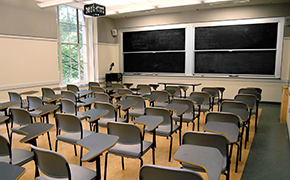Instructor Insights pages are part of the OCW Educator initiative, which seeks to enhance the value of OCW for educators.
Course Overview
This page focuses on the course 2.700/2.701 Principles of Naval Architecture as it was taught by Prof. Joel Harbour and Prof. Themistoklis Sapsis in Fall 2014.
This course is an introduction to principles of naval architecture. 2.700 is the undergraduate version of the course, and 2.701 is the graduate version. Both subjects meet together, but students in the graduate version complete additional assignments and are graded more stringently.
Course Outcomes
Course Goals for Students
Upon completion of the course students will have an introductory knowledge of naval ship design and construction, from ship geometry, hydrostatic performance, ship resistance, powering and propulsion along with intact and damage stability.
Possibilities for Further Study/Careers
After completing this course, students may continue to take ship design courses in the 2N program.
Graduates go on to become naval architecture engineers and managers in both commercial and government naval ship acquisition programs, new construction and maintenance facilities and research and design centers.
Curriculum Information
Prerequisites
Either of these courses satisfy the prerequisite:
Requirements Satisfied
2.700 can be applied toward a 2-OE degree (Bachelor of Science in Mechanical and Ocean Engineering), but it is not required.
Offered
Every fall semester.
Assessment
The students' grades were based on the following activities:
 40% Assignments and Projects
40% Assignments and Projects 15% Research Paper and Presentation
15% Research Paper and Presentation 45% Quizzes
45% QuizzesStudent Information

Breakdown by Year
A few undergraduates, but primarily graduate students.
Breakdown by Major
Most students were in the Mechanical Engineering department, which includes ocean engineering. A few students were from the Nuclear Engineering department.
Typical Student Background
Student backgrounds range from no experience but a general interest in ship design and construction, to commercial and naval ship operators and some design naval ship design experience.
Expected skills include a good understanding of engineering statics, free body diagrams, differential equations, and the ability to utilize computer aided design (CAD) tools.
During an average week, students were expected to spend 12 hours on the course, roughly divided as follows:
In Class/Lecture
- Met twice per week for 1.5 hours per session; 26 sessions total.
- Quizzes were taken during lecture sessions.
Recitation
- Met once per week for one hour per session; 11 sessions total.
- Work with computer aided drafting (CAD) tools.
- Review material for quizzes.
Out of Class
- Work on projects.
- Read and survey naval architecture literature.
- Study for quizzes.
Semester Breakdown
| WEEK | M | T | W | Th | F |
|---|---|---|---|---|---|
| 1 |  |  |  |  |  |
| 2 |  |  |  |  |  |
| 3 |  |  |  |  |  |
| 4 |  |  |  |  |  |
| 5 |  |  |  |  |  |
| 6 |  |  |  |  |  |
| 7 |  |  |  |  |  |
| 8 |  |  |  |  |  |
| 9 |  |  |  |  |  |
| 10 |  |  |  |  |  |
| 11 |  |  |  |  |  |
| 12 |  |  |  |  |  |
| 13 |  |  |  |  |  |
| 14 |  |  |  |  |  |
| 15 |  |  |  |  |  |
| 16 |  |  |  |  |  |
 No classes throughout MIT
No classes throughout MIT Lecture session
Lecture session Towtank lab
Towtank lab Assignment due date
Assignment due date Student presentations
Student presentations No class session scheduled
No class session scheduled Recitation session
Recitation session Guest lecture
Guest lecture Quiz
Quiz

 Room 1 of 1
Room 1 of 1 